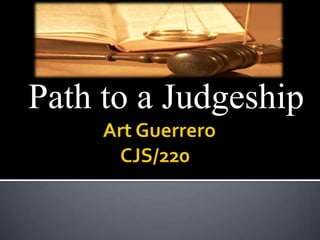
Path to a judgeship
- 2. Federal Appellate Judges The President of the United States The Senate
- 3. State Appellate Judges Merit System The Governor Partisan Election Nonpartisan Election
- 4. State Trial Court Judges Elections Merit System Governor
- 5. A Comparison of the Four Methods Appointment Election Partisan Merit
- 6. The Training of Judges University Degree Law School Practice Law Politics Public Relations
- 7. References CJS/220 week three readings What Training Do American Judges Do Before They Become a Judge? (2010) Retrieved July 15, 2010 from http://www.ehow.com/facts_5681269_training-do-before-become-judge_.html#ixzz0toFTbHE8
Notas del editor
- People do not become judges over night, there is a process that comes with becoming a judge of any type.
- The President of the United states appoints Federal Appellate Judges, but the Senate’s approval is required (CJS/220 week three readings). Article II of the U.S. Constitution states the President nominates and appoints them, but only after a review is done by the Senate (CJS/220 week three readings). Federal appellate judges hold their position for life, unless life circumstances do not permit them to perform their duties accordingly, they will be removed from office; or if they are impeached (CJS/220 week three readings).
- The Merit system is also known as the Missouri Plan, which gives the Governor the power to appoint a State Appellate Judge; with the input from a judicial nominating commission (CJS/220 week three readings). Five states that include California, New Hampshire, Maine, New Jersey, and New york, the State Appellate judges are appointed by the governor, without the input from the judicial nominating commission (CJS/220 week three readings). Partisan elections are where the candidates are identified by a political party, whereas Nonpartisan election do not mention there party affiliation (CJS/220 week three readings). The term a State Appellate Judge will vary from five to fifteen years, except in Massachusetts and New Hampshire, where they hold their position until the age of 70 (CJS/220 week three readings).
- A State Trial Court judge at the general level is usually appointed by election. Depending on which state it is, will determine if elections , the merit system, or if a governor will appoint you into judgeship (CJS/220 week three readings). Twelve states use the merit system, a majority of the states use the elections process. The courts with limited jurisdiction, the judges are appointed by the governor, the term for a trial court judge is two to fifteen years (CJS/220 week three readings).
- When a governor appoints a judge into judgeship they will be sure not to appoint someone that will not attract unwanted attention, for that would be a direct reflection of the governor (CJS/220 week three readings). The biggest downfall of using the appointed method is that it can also be the partisan method, for example a Republican will appoint a republican judge, rather than a judge that is democrat; even if they are more qualified, and vise versa (CJS/220 week three readings). One can even say it is a popularity contest, it’s not what you know, but who you know. The election method is probably the least bias of the methods because the judges are appointed by the people, but they can be partisan as well being that they are usually big supporters (CJS/220 week three readings). The Merit System is ran by the governor the bar association leadership, and the judicial nominating commission(CJS/220 week three readings). When it is all said and done for the most part all methods lead us back to politics.
- A judge must have a four year degree from a university, and usually major in business or criminal justice (e how, 2010). A judge must also have Juris Doctor degree which can only be earned at law school, after three years(e how, 2010). Future judges must also have expeirence with practicing law (e how, 2010). Whether you are appointed or elected as a judge you will need to have some political ties (e how, 2010). As far as public relations go, a judge must be trusted by the public, not to mention to be trustworthy and humble (e how, 2010). Forty years ago very little if any was given to those who wanted to become a judge (CJS/220 week three readings). Today the National Judicial college offers judicial training, as well as sentencing seminars for judges; another training source for judges is the Administrative office of the courts(CJS/220 week three readings).